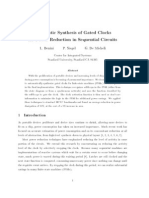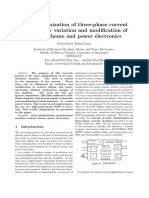Self-Timed SAPTL Using The Bundled Data Protocol: K.V.V.Satyanarayana T.Govinda Rao J.Sathish Kumar
Self-Timed SAPTL Using The Bundled Data Protocol: K.V.V.Satyanarayana T.Govinda Rao J.Sathish Kumar
Copyright:
Available Formats
Self-Timed SAPTL Using The Bundled Data Protocol: K.V.V.Satyanarayana T.Govinda Rao J.Sathish Kumar
Self-Timed SAPTL Using The Bundled Data Protocol: K.V.V.Satyanarayana T.Govinda Rao J.Sathish Kumar
Original Title
Copyright
Available Formats
Share this document
Did you find this document useful?
Is this content inappropriate?
Copyright:
Available Formats
Self-Timed SAPTL Using The Bundled Data Protocol: K.V.V.Satyanarayana T.Govinda Rao J.Sathish Kumar
Self-Timed SAPTL Using The Bundled Data Protocol: K.V.V.Satyanarayana T.Govinda Rao J.Sathish Kumar
Copyright:
Available Formats
International Journal Of Computational Engineering Research (ijceronline.com) Vol. 2 Issue.
Self-Timed SAPTL using the Bundled Data Protocol
K.V.V.Satyanarayana1T.Govinda Rao2J.Sathish Kumar3
Associate Professor K.L. University 2, 3 Assistant Professor Usha Rama college of Engg and technology
1
Abstract
This paper presents the design and implementation of a low-energy asynchronous logic topology using sense amplifier- based pass transistor logic (SAPTL). The SAPTL structure can realize very low energy computation by using low-leakage pass transistor networks at low supply voltages. The introduction of asynchronous operation in SAPTL further improves energydelay performance without a significant increase in hardware complexity. We show two different self-timed approaches: 1) the bundled data and 2) the dual-rail handshaking protocol. The proposed self-timed SAPTL architectures provide robust and efficient asynchronous computation using a glitch-free protocol to avoid possible dynamic timing hazards. Simulation and measurement results show that the self-timed SAPTL with dual-rail protocol exhibits energy-delay characteristics better than synchronous and bundled data self-timed approaches in 180-nm, 120-nm CMOS.
Keywords: pass transistor, self-timing, sense amplifier-based pass transistor logic (SAPTL) I. Introduction
A CMOS technology continues to scale, both supply Voltage and device threshold voltage must scale down Together to achieve the required performance. Lowering the supply voltage effectively reduces dynamic energy consumption but is accompanied by a dramatic increase in leakage energy due to the lower device threshold voltage needed to maintain performance [1].As a result, for low-energy applications, the leakage energy that the system can tolerate ultimately limits the minimum device threshold voltage. Speed, therefore, benefits little from technology scaling. The sense amplifier-based pass transistor logic (SAPTL) [2] is a novel circuit topology that breaks this tradeoff in order to achieve very low energy without sacrificing speed. The initial SAPTL circuits were designed to operate synchronously [2] but with the intent of being able to Operate asynchronously with some minor modifications. As the effects of process variations continue to increase dramatically with technology scaling, it is becoming harder to design variation-tolerant timing schemes using the traditional synchronous methodologies. To meet a certain timing requirement, the synchronous approach must use a very conservative worst case design that is slow enough for the needs of the statistically slowest circuit elements and, thus, will fail to exercise the whole capacity of statistically faster parts of the circuit. The asynchronous approach, on the other hand, can exploit local timing information to achieve average-case performance. An asynchronous design can get the best performance out of all components independent of statistical variations in local speed while guaranteeing correct circuit operation. Asynchronous operation is also attractive to the low-power designer. The absence of a clock distribution network can significantly reduce the power overhead needed to generate timing information. Furthermore, an idle asynchronous system avoids consuming any active power. Despite the advantages of asynchronous operation, the circuit complexity and performance overhead required to implement the needed handshaking protocol may not be trivial. The overhead cost might offset all benefits and make the asynchronous approach impractical. The SAPTL, however, offers a relatively easy way to realize asynchronous operation. Because of the differential signaling used, it is easy to determine when a logical operation completes. Therefore, the self-timed SAPTL topology is a promising candidate for reducing power consumption and improving speed in extremely low energy applications.
II. Saptl Architecture
The basic architecture of the SAPTL circuit is shown in Fig. 1. It is composed of a pass transistor stack, a driver, and a sense amplifier [2]. The SAPTL achieves low energy operation 1) by decoupling sub threshold leakage current from the stack threshold voltage, allowing for increased performance without an increase in leakage energy, and 2) by confining sub threshold leakage to well-defined and controllable paths found only in the drivers and sense amplifiers. Note that the total energy consumed by the SAPTL is composed of the following: 1) the energy used by the driver to energize the stack; 2) the energy used by the sense amplifier to resolve the correct logical levels and drive the inputs of the fan-out stacks; and (3) the energy needed to generate the appropriate timing information, either globally, such as clock distribution networks, or locally, as in handshaking circuits.
Issn 2250-3005(online) August| 2012
Page 1114
International Journal Of Computational Engineering Research (ijceronline.com) Vol. 2 Issue. 4
Fig.1 Architecture of SAPTL module with synchronous timing control. A. Stack and Driver The stack consists of an NMOS-only pass transistor tree with full-swing inputs and low-swing pseudo differential outputs to perform the required logic function, as shown in Fig. 2. The stack can implement any Boolean expression by connecting the min term branches of the tree to one output and the max term branches to the other as illustrated by the programming switches in the diagram. In our current implementation, the logic function of an SAPTL stack is determined and permanently fixed at fabrication by replacing the programming switches with hardwired connections. Because the stack has no supply rail connections, it does not contribute sub threshold leakage current, and it also has no gain.
Fig.2 Schematic of a two-input stack with Nstack =2. A driver, which is a simple inverter in this case, injects an evaluation current into the root of the stack. In operation, either Sout or Sout bar , but not both, is charged toward the supply rail when the driver energizes the selected path through the stack. After each computation and before every evaluation, both differential outputs are reset to ground (logical 0) to initialize the stack to a known state. This initialization is done by turning on all the transistors in the stack and draining the charges out through the root of the stack when the driver output is zero. The alternate charging and resetting of Sout or Sout bar realizes a standard dual-rail encoding scheme [3]. The speed of the SAPTL module depends strongly on the depth of the stack Nstack, which is defined as the number of transistors in series from the root node to the differential outputs. Because the stack contributes no sub threshold leakage current, the stack transistors can have a very low threshold voltage and still operate in the super threshold region even with a very low supply voltage. Therefore, SAPTL is a promising candidate to realize ultralow energy computation without entering the sub threshold region of operation [2]. B. Sense Amplifier The sense amplifier, shown in Fig. 3, serves three purposes: 1) it amplifies the low-voltage stack output, restoring the signal to full voltage; 2) it serves as a buffer stage at the output of the stack, so as to improve overall speed; and 3) it pre charges both its outputs to Vdd (logical 1), allowing the reset of the driven fan-out stacks. The sense amplifier consists of two stages. The first stage acts as a preamplifier to reduce the impact of mismatch in the actual technology environment, and the second stage acts as a cross-coupled latch which retains the processed data even after the stack is reset. The sense amplifier is designed to detect input voltages that are less than ,thus reducing the performance degradation due to the low stack voltage swings and the absence of gain in the pass transistor network. By turning off the driver as soon as the sense amplifier makes a decision, the stack voltage swings are kept to a minimum, reducing the energy required to perform the desired logical operation.
Issn 2250-3005(online)
August| 2012
Page 1115
International Journal Of Computational Engineering Research (ijceronline.com) Vol. 2 Issue. 4
Fig.3 Sense amplifier circuit. The leakage of the sense amplifier accounts for most of the leakage energy of the SAPTL module. It can be directly traded off against the input sensitivity of the sense amplifier to size and threshold voltage mismatch as shown in Fig. 4. Using a supply voltage of 300 mV and a minimum input voltage of 100 mV, 55% of the sense amplifier leakage is due to the four output buffers (inverters). Thus, an increase in sense amplifier performance can be achieved 1) by reducing the minimum input voltage or 2) by increasing the output drive of the sense amplifier, either of which would result in an increase in leakage current.
III. Bundled Data Self-Timed Saptl Design
The circuit implementation of the self-timed SAPTL module using the bundled data protocol [7] is shown in Fig. 4. The main data path, composed of a driver and stack, evaluates data or resets after receiving the request signal Rqein and data input signals Din and Din bar from the previous SAPTL stage. The control path, which consists of a delay line and a C-element, produces the local clock signal Enable to trigger the sense amplifier.
Fig.4 Architecture of self-timed SAPTL module with bundled data protocol. The delay line mimics the delay of the stack to generate the control signal Ready indicating that the stack has finished an operation. The C-element then produces Enable by collecting Ready and the acknowledge signal Ackin from the next SAPTL stage. In multiple fan-in and fan-out situations, additional C-element can be employed to reconverge multiple request and acknowledge events from the different fan-in and fan-out stages. When triggered by Enable , the sense amplifier latches the stack output data or resets depending on the logical state of Enable. The full-swing data output signals Dout and Dout bar are made available at the outputs of the sense amplifier. The AND gate serves
Issn 2250-3005(online)
August| 2012
Page 1116
International Journal Of Computational Engineering Research (ijceronline.com) Vol. 2 Issue. 4
Fig.5 Timing diagram of self-timed SAPTL. As a completion detection circuit, generating the handshake signals Ackout and Requot that indicate the completion of the current operation. We can summarize the relationship between the input and output signals of the th SAPTL stage as
IV. Dual-Railself-Timed Saptl Design
In a self-timed SAPTL structure using the bundled data protocol, RTA2 is the most critical design constraint. In order to guarantee correct operation under process, voltage, and temperature variations, the latency of the delay line can become very large and can severely limit the overall performance. Because the SAPTL uses dual-rail coding to represent data, we can use the output signals of the stack and, instead of from the delay line, to trigger the C-element. As a result, we can 1) eliminate the delay line and 2) design the C-element to respond immediately after the stack finishes operation, without being limited by RTA2. Furthermore, we can combine the sense amplifier and C-element circuits into a composite block through gate-level optimization, yielding a more energy-efficient architecture, as shown in Fig.7. The optimized architecture with dual-rail protocol [7] eliminates the traditional
Fig.6 Architecture of glitch-free self-timed SAPTL module with dual-rail protocol.
Issn 2250-3005(online) August| 2012
Page 1117
International Journal Of Computational Engineering Research (ijceronline.com) Vol. 2 Issue. 4
Sense amplifier circuit and directly employs two C-element circuits as a complex gain stage at the outputs of the stack. The overall conversion speed, however, may be slower than the design with a sense amplifier due to the absence of a differential amplification and
Fig.7 Logic combination of two-input C element and sense amplifier circuits. The loss the loss of a positive-feedback mechanism between the two data paths Fig.6 shows the implementation of a glitch-free self-timed SAPTL architecture without the delay line.
Fig.7: Two-input C-element circuit with additional decision-making logic for glitch-free self-timed SAPTL. The design and performance of the C-element circuits are particularly important in this architecture because the Celement not only plays the role of the gain stage but also serves as the handshaking element. The self-timed SAPTL with dual-rail protocol has latency and cycle time expressions similar to (4)(8). Note that the speed enhancement discussed in Section IV-C does not apply to the dual-rail design in Fig.6, because of the absence of the internal signal. However, the single self-timed SAPTL stage is now elastic and able to achieve the best performance across process, voltage, and temperature variations and different input characteristics. The self-timed SAPTL can thus exercise the full potential of asynchronous computation without the limitations of the delay line. It is interesting tonote that the optimized self-timed SAPTL architecture in Fig.6. Has almost the same hardware complexity as the original synchronous SAPTL design in Fig. 1. This means that, with almost zero cost, SAPTL is able to achieve both better performance and better robustness in the presence of variability by operating asynchronously.
Fig.8 Test setup for energy and delay measurements. The energy and delay of the various SAPTL5 Implementations were measured using N=8.
Issn 2250-3005(online) August| 2012
Page 1118
International Journal Of Computational Engineering Research (ijceronline.com) Vol. 2 Issue. 4
V. Performance Evaluation And Comparison
We evaluated and compared the performance of the self-timed and synchronous SAPTL circuits using the Spectre circuit simulator. We also performed Monte Carlo simulations to ensure the correct operation of the SAPTL circuits even with 6 process variations. In addition, we implemented the self-timed SAPTL circuits in a 120-nm CMOS test chip and compared the actual measurement results to the simulated data. This section presents the energy-delay and leakage comparisons of synchronous versus self-timed SAPTL. The simulations exclude the parasitic contributions from the interconnect wires and the clock network. However, the effect of global parameters, such as clocks and long interconnect wires, should be done at the system level, in the context of an actual application. Comparisons between the synchronous SAPTL and other logic styles can be found in [2].
Fig .9.1 Simulation results
Fig .9.2 Layout design for Bundled Data Self-Timed SAPTL
Fig .9.3 Layout design for Dual-rail-self timed SAPTL Energy-Delay Characteristics The pre-layout simulated energy and delay behavior of the synchronous SAPTL5 and both versions of the self-timed SAPTL5 is shown in Fig.9.4.
Issn 2250-3005(online) August| 2012
Page 1119
International Journal Of Computational Engineering Research (ijceronline.com) Vol. 2 Issue. 4
Fig.9.4 Measured versus simulated energy-delay plots for The 120-nm CMOS Self-timed SAPTL5, as the supply Voltage is varied from 300 mV to 1.2 V Technology Power (180 nm Technology) 16.87W 16.35W 15.64W Power (120 nm Technology) 16.58W 15.64W 6.99W
synchronous Bundled-data Dual-rail
Table .1 Comparisons of different Methodologies
V. Conclusion
The asynchronous operation of the SAPTL provides robustness in the presence of variability as well as performance advantages over synchronous operation. While the self-timed SAPTL using the bundled data protocol can potentially achieve higher speed performance by overlapping the data evaluation and reset cycle, the self-timed design based on the dual-rail protocol has less rigid relative timing constraints, which leads to better energy and speed performance in technologies with increased process variations. The early reset operation ofself-timed SAPTL not only prevents dynamic timing hazards from glitches but also improves both energy and speed performance. We evaluated and compared the performance of the selftimed and synchronous SAPTL circuits using the Spectre circuit simulator. We also performed Monte Carlo simulations to ensure the correct operation of the SAPTL circuits even with process variations. In addition, we implemented the self-timed SAPTL circuits a 120-nm CMOS test chip and compared the actual measurement results is less than the simulated data. And also 180-nm CMOS is less than the simulated data This section presents the energy-delay and leakage comparisons of synchronous versus self-timed SAPTL. The simulations exclude the parasitic contributions from the interconnect wires and the clock network. However, as pointed out earlier in Section II-D, the effect of global parameters, such as clocks and long interconnect wires, should be done at the system level, in the context of an actual application. Comparisons between the synchronous SAPTL and other logic styles can be found in [2]. REFERENCES [1] T. Sakurai, Perspectives on power-awar electronics, in ISSCC Dig. Te ch. Papers, 2003, vol.1, pp. 2629. [2] L. Alarcn, T.-T. Liu, M. Pierson, and J. Rabaey, Exploring very lowenergy logic: A case study, J. Low Power Electron., vol. 3, no. 3, pp. 223233, Dec. 2007. [3] J. Spars and S. Furber, Principles of Asynchronous Circuit Design.Norwell, MA: Kluwer, 2001. [4] J. Rabaey, A. Chandrakasan, and B. Nikolic, Digital Integrated Circuits:A Design Perspective, 2nd ed . Englewood Cliffs, NJ: Prentice-Hall, 2003. [5] H. Li, S. Bhunia, Y. Chen, K. Roy, and T. Vijaykumar, DCG: deterministic clock-gating for low-power microprocessor design, IEEE Trans. Very Large Scale Integr. (VLSI) Syst., vol. 12, no. 3, pp. 245254,Mar. 2004.
Issn 2250-3005(online) August| 2012
Page 1120
International Journal Of Computational Engineering Research (ijceronline.com) Vol. 2 Issue. 4
[6] [7] [8] [9] [10] [11] [12] 13] [14] [15] [16]
N. Banerjee, K. Roy, H. Mahmoodi, and S. Bhunia, Low power synthesis of dynamic logic circuits using finegrained clock gating, in Proc. DATE, Mar.2006, vol. 1, pp. 16. T.-T. Liu, L. Alarcn, M. Pierson, and J. Rabaey, Asynchronous computing in sense amplifier-based pass transistor logic, in Proc. 14th IEEE Int. Symp. ASYNC, Apr. 2008, pp. 105115. T. Williams, Performance of iterative computation in self-timed rings, J. VLSI Signal Process., vol. 7, no. 1/2, pp. 1731, Feb. 1994. K. Stevens, R. Ginosar, and S. Rotem, Relative timing, IEEE Trans. Very Large Scale Integr. (VLSI) Syst., vol. 11, no. 1, pp. 129140, Feb. 2003. I. Sutherland, Micropipelines, Commun. ACM, vol. 32, no. 6, pp.720738, Jun.1989. S. Narendra, Scaling of stack effect and its application for leakage reduction, in Proc. ISLPED, Aug. 2001, pp. 195200. K. Yano, Y. Sasaki, K. Rikino, and K. Seki, Top- down pass-transistor logic design. IEEE Journal of Solid-State Circuits 31, 792 (1996). R. Shelar and S. Sapatnekar, BDD decomposition for delay oriented pass transistor logic synthesis. IEEE Transactions on Very Large Scale Integration (VLSI) Systems 13, 957 (2005). P. Buch, A. Narayan, A. Newton, and A. Sangiovanni-Vincentelli, Logic synthesis for large pass transistor circuits. IEEE/ACM International Conference on Computer-Aided Design, November (1997), pp. 663670. W. C. Elmore, The transient analysis of damped linear networks with particular regard to wideband amplifiers. J. Appl. Phys. 19, 55 (1948). V. Kheterpal, V. Rovner, T. Hersan, D. Motiani, Y. Takegawa, A. Strojwas, and L. Pileggi, Design methodology for IC manufacturability based on regular logic-bricks. Proceedings of the 42nd Design Automation Conference, June (2005), pp. 353358.
K. V. V. Satyanarayana received the M.Tech degree from Jawaharlal Nehru Technological University, Kakinada in 2008 in Electronics and Communication engineering. He is an Associate Professor in the Department of Electronics and Communication engineering, K.L.University,Vaddeswaram. His current research interests include the area of Communications, video coding techniques, and Architectures design.
T. GOVINDA RAO received the M.Tech (VLSISD) degree from Jawaharlal Nehru Technological University, Kakinada in 2011 in Electronics and Communication engineering. he is an Assistant Professor in the Department of Electronics and Communication engineering, Usha Rama College Of Engineering and Technology, Vijayawada. His current research interests include the areas of very large scale integration (VLSI) testing and fault-tolerant computing, video coding techniques, and Architectures design.
J. SATHISH KUMAR received the M.Tech degree from Jawaharlal Nehru Technological University, Hyderabad in 2011 in Electronics and Communication Engineering. He is an Assistant Professor in the Department of Electronics and Communication Engineering, Usha Rama College of Engineering and Technology, Vijayawada. His current research interests include the areas of very large scale integration (VLSI) testing and fault-tolerant computing, video coding techniques and Architectures design.
Issn 2250-3005(online)
August| 2012
Page 1121
You might also like
- Double Tail ComparatorDocument32 pagesDouble Tail ComparatormdlogicsolutionsNo ratings yet
- Low Power Design of Digital SystemsDocument28 pagesLow Power Design of Digital SystemssuperECENo ratings yet
- Analysis and Optimization of Active Power and Delay of 10T Full Adder Using Power Gating Technique at 45 NM TechnologyDocument7 pagesAnalysis and Optimization of Active Power and Delay of 10T Full Adder Using Power Gating Technique at 45 NM TechnologyInternational Organization of Scientific Research (IOSR)No ratings yet
- Automatic Synthesis of Gated Clocks For Power Reduction in Sequential CircuitsDocument21 pagesAutomatic Synthesis of Gated Clocks For Power Reduction in Sequential CircuitsKavya NaiduNo ratings yet
- Automated Design Techniques For Low-Power High-Speed CircuitsDocument4 pagesAutomated Design Techniques For Low-Power High-Speed CircuitsIrma AmeliaNo ratings yet
- Power Reduction Through RTL Clock GatingDocument10 pagesPower Reduction Through RTL Clock GatingAishwarya TekkalakotaNo ratings yet
- Calculation of TmsDocument6 pagesCalculation of TmsMihir PatelNo ratings yet
- VLSI Low Power DesignDocument4 pagesVLSI Low Power DesignBadrinath GopendranNo ratings yet
- A Mosfet-Only Dac For A General Array Configured Device: E. Montane, G. Hornero, G. Chapinal, J. SamitierDocument5 pagesA Mosfet-Only Dac For A General Array Configured Device: E. Montane, G. Hornero, G. Chapinal, J. SamitierMiguel BrunoNo ratings yet
- Welcome To International Journal of Engineering Research and Development (IJERD)Document6 pagesWelcome To International Journal of Engineering Research and Development (IJERD)IJERDNo ratings yet
- Low Power Register Design With Integration Clock Gating and Power GatingDocument6 pagesLow Power Register Design With Integration Clock Gating and Power GatingInternational Journal of Application or Innovation in Engineering & ManagementNo ratings yet
- Design and Optimization of ÷8/9 Divider in PLL Frequency Synthesizer With Dynamic Logic (E - TSPC)Document5 pagesDesign and Optimization of ÷8/9 Divider in PLL Frequency Synthesizer With Dynamic Logic (E - TSPC)himaja1No ratings yet
- Design and Micro Controller Implementation of A Three Phase SCR Power ConverterDocument8 pagesDesign and Micro Controller Implementation of A Three Phase SCR Power ConverterIsmael Ochoa JimenezNo ratings yet
- RTL Design Techniques To Reduce The Power Consumption of FPGA Based CircuitsDocument6 pagesRTL Design Techniques To Reduce The Power Consumption of FPGA Based Circuitsraees74No ratings yet
- A 1.8Ghz Cmos: Low-Power Truly-Modular Programmable Divider in Standard TechnologyDocument4 pagesA 1.8Ghz Cmos: Low-Power Truly-Modular Programmable Divider in Standard TechnologyMuhammad_Swilam_2010No ratings yet
- A Design Approach For Fine-Grained Run-Time Power Gating Using Locally Extracted Sleep SignalsDocument7 pagesA Design Approach For Fine-Grained Run-Time Power Gating Using Locally Extracted Sleep Signalsthamy_15No ratings yet
- Clock GatingDocument10 pagesClock Gatingpavanmk2501No ratings yet
- Design and Analysis of Double Tail Comparator Using Adiabatic LogicDocument7 pagesDesign and Analysis of Double Tail Comparator Using Adiabatic LogicIJSTENo ratings yet
- Final ProjectDocument5 pagesFinal Projectnksharma.naveen1855No ratings yet
- Analysis of Energy Efficient PTL Based Full Adders Using Different Nanometer TechnologiesDocument6 pagesAnalysis of Energy Efficient PTL Based Full Adders Using Different Nanometer TechnologiesDwarakaManeekantaAddagiriNo ratings yet
- A Low Power A - D Converter 05613669Document4 pagesA Low Power A - D Converter 05613669Romualdo Begale PrudêncioNo ratings yet
- PCX - ReportDocument15 pagesPCX - ReportChristopher crNo ratings yet
- DTC Drive With ANN-Based Stator Flux Estimator (2005)Document10 pagesDTC Drive With ANN-Based Stator Flux Estimator (2005)leosensNo ratings yet
- 4 Bit Fast Adder Design Topology and Layout With Self Resetting Logic For Low Power VLSI Circuits 197 205Document9 pages4 Bit Fast Adder Design Topology and Layout With Self Resetting Logic For Low Power VLSI Circuits 197 205MohamedNo ratings yet
- MATLAB-based Simulation of Three-Level PWM Inverter-Fed Motor Speed Control SystemDocument6 pagesMATLAB-based Simulation of Three-Level PWM Inverter-Fed Motor Speed Control Systemraviraj_kumbhar1988No ratings yet
- An Efficient Differential Conditional Capturing Energy Recovery Flip-Flop DesignDocument6 pagesAn Efficient Differential Conditional Capturing Energy Recovery Flip-Flop DesignRaghul RamasamyNo ratings yet
- A 1.8V 12-Bit 230-MS/s Pipeline ADC in 0.18 M CMOS TechnologyDocument4 pagesA 1.8V 12-Bit 230-MS/s Pipeline ADC in 0.18 M CMOS Technologyfaithfully_fatihNo ratings yet
- High-Voltage Non-Overlapping Clock Generators For Switched-Capacitor DC-DC ConvertersDocument4 pagesHigh-Voltage Non-Overlapping Clock Generators For Switched-Capacitor DC-DC ConvertersNidhi ShuklaNo ratings yet
- GSM Based Automatic Substation Load Shedding and Sharing Using Programmable Switching ControlDocument3 pagesGSM Based Automatic Substation Load Shedding and Sharing Using Programmable Switching Controlmohit123ashuNo ratings yet
- Gate Level LeakageDocument4 pagesGate Level LeakageMadu KumarNo ratings yet
- A High-Speed/Low-Power Multiplier Using An Advanced Spurious Power Suppression TechniqueDocument4 pagesA High-Speed/Low-Power Multiplier Using An Advanced Spurious Power Suppression TechniqueBappy DebnathNo ratings yet
- My PaperDocument11 pagesMy PaperkavyapirangiNo ratings yet
- Speed Control of Single Phase Induction Motor Using Infrared Receiver ModuleDocument6 pagesSpeed Control of Single Phase Induction Motor Using Infrared Receiver ModuleSanjay ShelarNo ratings yet
- A Survey On Sequential Elements For Low Power Clocking SystemDocument10 pagesA Survey On Sequential Elements For Low Power Clocking SystemJournal of Computer ApplicationsNo ratings yet
- Techniques For Low Power VLSI Design: A Novel Analysis of Leakage Power ReductionDocument4 pagesTechniques For Low Power VLSI Design: A Novel Analysis of Leakage Power ReductionSaranya RamaswamyNo ratings yet
- KKKDocument13 pagesKKKVineet KushwahNo ratings yet
- A Low-Power and High-Speed Voltage Level Shifter Based On A Regulated Cross-Coupled Pull-Up NetworkDocument5 pagesA Low-Power and High-Speed Voltage Level Shifter Based On A Regulated Cross-Coupled Pull-Up Network15022000rskushalNo ratings yet
- Dynamic Power Reduction WPDocument6 pagesDynamic Power Reduction WPRanganadh MvNo ratings yet
- Paper - 5 Noise MinimizationDocument5 pagesPaper - 5 Noise MinimizationLTE002No ratings yet
- Low Power 6-Transistor Latch Design For Portable DevicesDocument16 pagesLow Power 6-Transistor Latch Design For Portable DevicesjayalakshmisnairNo ratings yet
- Design of Adder in Multiple Logic Styles For Low Power Vlsi: K.Venkata Siva Reddy, C.VenkataiahDocument6 pagesDesign of Adder in Multiple Logic Styles For Low Power Vlsi: K.Venkata Siva Reddy, C.Venkataiahsurendiran123No ratings yet
- ASIC For Low Voltage Air Circuit Breaker AE-SW SeriesDocument3 pagesASIC For Low Voltage Air Circuit Breaker AE-SW SeriesmaheshNo ratings yet
- Comparative Analysis of Different Clock Gating TechniquesDocument55 pagesComparative Analysis of Different Clock Gating Techniquesvsangvai26No ratings yet
- Design of An ADC Using High Precision Comparator With Time Domain Offset CancellationDocument4 pagesDesign of An ADC Using High Precision Comparator With Time Domain Offset CancellationijtetjournalNo ratings yet
- Xiaoyan Cheng, and Haigang Yang: A Cmos Field Programmable Analog Array For Intelligent Sensory ApplicationDocument4 pagesXiaoyan Cheng, and Haigang Yang: A Cmos Field Programmable Analog Array For Intelligent Sensory ApplicationashishmanyanNo ratings yet
- Microcontroller Based Advanced Triggering Circuit For Converters/InvertersDocument6 pagesMicrocontroller Based Advanced Triggering Circuit For Converters/Inverterszameer0509No ratings yet
- DSP Based Real Time Implementation of AC-DC-AC Converter Using SPWM TechniqueDocument18 pagesDSP Based Real Time Implementation of AC-DC-AC Converter Using SPWM Techniquebalamurugan041992No ratings yet
- Sub-Threshold Adiabatic Logic For Low Power ApplicationsDocument7 pagesSub-Threshold Adiabatic Logic For Low Power ApplicationsarcherselevatorsNo ratings yet
- Robust Subthreshold Circuit Designing Using Sub-Threshold Source Coupled Logic (STSCL)Document5 pagesRobust Subthreshold Circuit Designing Using Sub-Threshold Source Coupled Logic (STSCL)Sonu SangwanNo ratings yet
- Det FF PDFDocument5 pagesDet FF PDF09mitratNo ratings yet
- High-Speed Low-Power Viterbi Decoder Design For TCM DecodersDocument20 pagesHigh-Speed Low-Power Viterbi Decoder Design For TCM DecodersPooja BanNo ratings yet
- DRDDocument16 pagesDRDAnushree SaranNo ratings yet
- Implementation of Low Power Test Pattern Generator Using LFSRDocument6 pagesImplementation of Low Power Test Pattern Generator Using LFSRIjsrnet EditorialNo ratings yet
- Analysis, Design, and Implementation of A High-Efficiency Full-Wave Rectifier in Standard CMOS TechnologyDocument11 pagesAnalysis, Design, and Implementation of A High-Efficiency Full-Wave Rectifier in Standard CMOS TechnologymohsinmanzoorNo ratings yet
- A Novel High Speed and Energy Efficient 10 Transistor Full Adder DesignDocument20 pagesA Novel High Speed and Energy Efficient 10 Transistor Full Adder Designneethusebastian1989No ratings yet
- Analysis of Cmos and Mtcmos Circuits Using 250 Nano Meter TechnologyDocument11 pagesAnalysis of Cmos and Mtcmos Circuits Using 250 Nano Meter TechnologyCS & ITNo ratings yet
- SOC Implementation Wave-Pipelined: VenkataramaniDocument8 pagesSOC Implementation Wave-Pipelined: VenkataramaniRamesh PrasadNo ratings yet
- High-Performance D/A-Converters: Application to Digital TransceiversFrom EverandHigh-Performance D/A-Converters: Application to Digital TransceiversNo ratings yet
- Reference Guide To Useful Electronic Circuits And Circuit Design Techniques - Part 2From EverandReference Guide To Useful Electronic Circuits And Circuit Design Techniques - Part 2No ratings yet
- Parametric Study On Analysis and Design of Permanently Anchored Secant Pile Wall For Earthquake LoadingDocument16 pagesParametric Study On Analysis and Design of Permanently Anchored Secant Pile Wall For Earthquake LoadingInternational Journal of computational Engineering research (IJCER)No ratings yet
- A Real Time Abandoned Object Detection and Addressing Using IoTDocument5 pagesA Real Time Abandoned Object Detection and Addressing Using IoTInternational Journal of computational Engineering research (IJCER)No ratings yet
- Parametric Study On Analysis and Design of Permanently Anchored Secant Pile Wall For Earthquake LoadingDocument16 pagesParametric Study On Analysis and Design of Permanently Anchored Secant Pile Wall For Earthquake LoadingInternational Journal of computational Engineering research (IJCER)No ratings yet
- PCB Faults Detection Using Image ProcessingDocument5 pagesPCB Faults Detection Using Image ProcessingInternational Journal of computational Engineering research (IJCER)No ratings yet
- Conceptual Design and Structural Analysis of Solid Rocket Motor CasingDocument6 pagesConceptual Design and Structural Analysis of Solid Rocket Motor CasingInternational Journal of computational Engineering research (IJCER)No ratings yet
- Relationship Between Refractive Index, Electronic Polarizavility, Optical Energy Gap Optical Electronegativity and Plasmon Energy in I-Iii-Vi2 and Ii-Iv-V2 Groups of Semi Conductors.Document5 pagesRelationship Between Refractive Index, Electronic Polarizavility, Optical Energy Gap Optical Electronegativity and Plasmon Energy in I-Iii-Vi2 and Ii-Iv-V2 Groups of Semi Conductors.International Journal of computational Engineering research (IJCER)No ratings yet
- Fundamentals of Computer Programming: Course IntroductionDocument38 pagesFundamentals of Computer Programming: Course IntroductionHumza ZahidNo ratings yet
- EBS올독기1 변형문제 9강 15문제 배포용Document5 pagesEBS올독기1 변형문제 9강 15문제 배포용t31776284No ratings yet
- What Is Planning?Document9 pagesWhat Is Planning?2021487152No ratings yet
- Keeping Quiet Poem Notes Class 12Document10 pagesKeeping Quiet Poem Notes Class 12Disha Sethi100% (1)
- Freddy Jackson Brown and Duncan Gillard - The 'Strange Death' of Radical BehaviourismDocument4 pagesFreddy Jackson Brown and Duncan Gillard - The 'Strange Death' of Radical BehaviourismIrving Pérez MéndezNo ratings yet
- G10 4TH NotesDocument6 pagesG10 4TH Notesmarife gupaalNo ratings yet
- 20-26 November 2010Document16 pages20-26 November 2010pratidinNo ratings yet
- SETSDocument27 pagesSETSAna Marie ValenzuelaNo ratings yet
- English For Academic and Propfessional Purposes - L09Document10 pagesEnglish For Academic and Propfessional Purposes - L09iriszhykeNo ratings yet
- Calcium Aluminate Cements: Proceedings of The Centenary Conference 2008Document12 pagesCalcium Aluminate Cements: Proceedings of The Centenary Conference 2008petemberNo ratings yet
- Instructions (90585) : Three Year WarrantyDocument4 pagesInstructions (90585) : Three Year WarrantyprogramaincNo ratings yet
- Interrupt Structure in 8085Document17 pagesInterrupt Structure in 8085Vinod SrinivasanNo ratings yet
- MVC Life CycleDocument5 pagesMVC Life CycleNaga Sai BabuNo ratings yet
- Awareness About Cash Less Economy Among Students: K. Girija & M. NandhiniDocument8 pagesAwareness About Cash Less Economy Among Students: K. Girija & M. NandhiniTJPRC PublicationsNo ratings yet
- Ujian MindaDocument10 pagesUjian MindaRd manNo ratings yet
- IC201111 EOM Individual AssignmentDocument11 pagesIC201111 EOM Individual AssignmentMruga JoshiNo ratings yet
- System Verilog Verification BasicsDocument38 pagesSystem Verilog Verification BasicsHardik TrivediNo ratings yet
- Zhan Zhuang: Chinese Medicine) reference《Huang DiDocument2 pagesZhan Zhuang: Chinese Medicine) reference《Huang DiMladen PopovićNo ratings yet
- Lise Bourbeau Despre Frici Si CredinteDocument134 pagesLise Bourbeau Despre Frici Si CredinteArens Simona100% (2)
- Department of Education: SBM Level of PracticeDocument5 pagesDepartment of Education: SBM Level of PracticeJOLI MAE SATONo ratings yet
- Teaching Music To Autistic ChildrenDocument4 pagesTeaching Music To Autistic ChildrenBárbara de SouzaNo ratings yet
- Mother Tongue Bow GR 123 Q1Document34 pagesMother Tongue Bow GR 123 Q1ANNA MARIE LARGADAS MALULAN100% (4)
- XP Command LineDocument4 pagesXP Command Lineraghv100% (1)
- Chapter 13Document37 pagesChapter 13PRIYANKA H MEHTANo ratings yet
- A Rope of Mass 0.65 KG Is Stretched Between Two Supports 30 M Apart. If The Tension in The Rope Is 120 N, How Long Will It Take A Pulse To Travel From One Support To The Other?Document6 pagesA Rope of Mass 0.65 KG Is Stretched Between Two Supports 30 M Apart. If The Tension in The Rope Is 120 N, How Long Will It Take A Pulse To Travel From One Support To The Other?peyying12No ratings yet
- 10 Principles For ReadingDocument18 pages10 Principles For ReadingBrenda Lara RuizNo ratings yet
- Development/Dp/0132952610/Ref PD - Sbs - 14 - 3? - Encoding Utf8&Psc 1&refrid 7N775Pq6Czm20 6X8Tpr1Document16 pagesDevelopment/Dp/0132952610/Ref PD - Sbs - 14 - 3? - Encoding Utf8&Psc 1&refrid 7N775Pq6Czm20 6X8Tpr1vaduva_ionut_2No ratings yet
- R01 - Aronson 1959 - The Effect of Severity of Initiation On Liking For A GroupDocument3 pagesR01 - Aronson 1959 - The Effect of Severity of Initiation On Liking For A GroupGrupa5No ratings yet
- Synopsis For Planetarium and Astronomy Museum @vizagDocument12 pagesSynopsis For Planetarium and Astronomy Museum @vizagabdulrehmanxftNo ratings yet
- Annotated BibliographyDocument7 pagesAnnotated Bibliographyapi-251423372No ratings yet






























































































